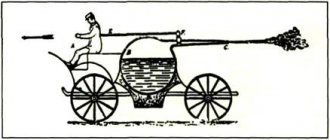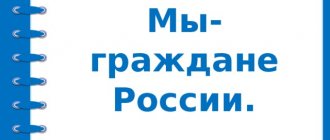Lesson plan for 5th grade on the topic “Single-valued and polysemantic words”
Lesson plan for the 5th grade on teaching materials, edited by V.V. Babaytseva.
"Single-valued and polysemous words"
The purpose of the lesson
: formation of the concepts of “unambiguous” and “multi-valued” words.
Lesson objectives:
- Educational:
- repeat the studied material on the topic “Lexical meaning of a word”;
- learn material about single-valued and polysemantic words;
- understand the concept of “dictionary entry”.
2) Developmental:
- consolidate the ability to determine the lexical meaning of a word and a word by its lexical meaning;
- develop the ability to use a dictionary;
— to develop the ability to determine the lexical meaning of a polysemantic word;
— to develop the ability to determine the lexical meaning of a word using an explanatory dictionary.
3) Educational:
— to cultivate such qualities as attentiveness, perseverance, love of the Russian language, love of books;
— foster a culture of mental work.
Lesson equipment:
- Textbook;
- Dictionary;
- Handout.
Lesson plan:
- Repetition of the studied material about the lexical meaning of the word:
— vocabulary dictation with the definition of a word according to its lexical meaning;
2. Mastering material about single-valued and polysemantic words:
— introduction to the topic;
— independent formulation of basic concepts;
— analysis of the dictionary entry of a polysemantic word in explanatory dictionaries.
3. Formation of skills:
— selective cheating;
- composing phrases with polysemantic words.
4. Results. Assessment.
During the classes:
- Hello guys! Let's start the lesson with a vocabulary dictation. Please note that the words themselves will not be named. You will have to determine by the lexical meaning of the word what subject we are talking about and write it down in your notebook.
- A group of people who determine prizes, award prizes and awards at competitions and competitions (jury);
- The stem of a plant at the very beginning of its development (sprout);
- Flat ground surface (plain);
- Dark skin color from long exposure to the sun (tanning);
- Bright illumination of the horizon before sunrise or after sunset (dawn);
Let's check what you got.
Student answers
What is lexical meaning?
What does knowledge about the lexical meaning of a word give?
Sample answer: a) Helps distinguish one word from another; b) the spelling of some words depends on the lexical meaning of the word: caress the kitten - rinse the clothes
Where can I find the exact lexical meaning of a word?
Before you is “Explanatory Dictionary of the Russian Language” by S.I. Ozhegov and N.Yu. Shvedova. There is also a unique dictionary “Explanatory Dictionary of the Living Great Russian Language V.I. Dahl."
The lexical meaning of words is explained in explanatory dictionaries in three ways:
- Selection of synonyms;
- Selection of antonyms;
- Descriptive.
You can check all this in practice.
- Refer to the leaflets that are on your tables. Read the sentences and determine the meaning of the highlighted words. Use a dictionary when completing this task.
- Spring is the time to plow
the land (earth is the fertile layer of soil); - The Earth
revolves around the Sun (Earth is a celestial body, planet); - - Look!
Earth! Earth ! - the sailor on watch shouted (earth in the meaning of dry land); - And beyond this river
is the land of Poland,” said our guide (land is the territory of the state)
Read what you got?
What conclusion can be drawn?
The word "earth" has several meanings.
Such words are called ambiguous! Write down the topic of the lesson in the line left in advance: “Single-valued and polysemantic words”
Write the definitions in the dictionary:
Words that have several lexical meanings are called MULTI-SECONIC. A polysemantic word has one meaning associated with another.
Words that have only one meaning are called UNIQUE.
Look up the word “earth” in the explanatory dictionary and pay attention to how the polysemy of the word is indicated.
Each meaning of a polysemantic word is numbered and written in one dictionary entry.
- Based on the knowledge you have acquired, make a table using the material on your desks: in the left column, write down nouns that have only one meaning; on the right are polysemantic words.
| Single meaning words | Ambiguous words |
| Spring | It's time |
| Plowing | Earth |
| Sailor | Sun |
| River | |
| Conductor |
Read the words you wrote in the left column, then in the right.
What conclusion can be drawn?
More ambiguous words
- Let's summarize the lesson.
How to distinguish unambiguous words from ambiguous ones?
Why is it necessary to know the lexical meaning of a word?
Giving and commenting on ratings.
Homework:
determine the meaning of the word “bread”, create phrases with the word “bread” in all its meanings.
Test "Single-valued and polysemantic words"
- Good afternoon, have a seat!- Show me your hands.
- Why did someone show me a ballpoint pen, and someone show me a hand? What confused you? (The word “handle”; it is not immediately clear what exactly was asked for).
- Why was it not clear? (The word “handle” has several meanings/lexical meanings).
— In what literature can we find the lexical meaning of the word? (In explanatory dictionaries).
- By what principle are words arranged in the dictionary? (Alphabetically).
— Let’s get acquainted with the meaning of the word pen (1 student reads an excerpt from a dictionary entry):
HANDLE, -i, f. 1. The part of an object by which it is held or grasped by hand. Door r. R. teapot, suitcase, saw. 2. Part of the furniture that serves as a support for the arms, an armrest. R. chairs. Sofa arms. 3. Writing implement - an extended holder for a pen or refill. Automatic r. Sharikovaya r. (Dictionary by S.I. Ozhegov)
— What other information can we get from a dictionary entry? (An excerpt from the dictionary is duplicated on the slide.) What does the letter “-i” mean after the word “handle”? (Which is the plural ending “-and” - handles).
- Now show me your hands.
— Why did you show only ballpoint pens? (Because one of the meanings of the word “pen” is a writing instrument/writing utensil).
— How many meanings does the word “handle” have? (Three)
— What can you call a word that has several lexical meanings? (Multiple meanings).
— What about words that have the same lexical meaning? (Unambiguous).
— What do you think is the topic of today’s lesson? (Lexical meaning, ambiguous and unambiguous words, etc.)
— The topic of today’s lesson is “Ambiguous and unambiguous words.”
Examine the card, circle with a simple
pencil
the numbers of points whose information is already known, put
a simple pencil
next to the points whose information needs to be clarified or is unknown.
Card #1:
Any word has a lexical meaning.
The dictionary by which the lexical meaning of a word is determined is called the “Explanatory Dictionary”
Some words have multiple meanings.
The word is unambiguous because it has one meaning.
If a word has several lexical meanings, it is called polysemous.
The science that studies the vocabulary of a language is called lexicology.
— What tasks will we set for ourselves in the lesson? (Learn more about single-valued and polysemous words, we will continue to learn how to work with dictionaries, etc.)



